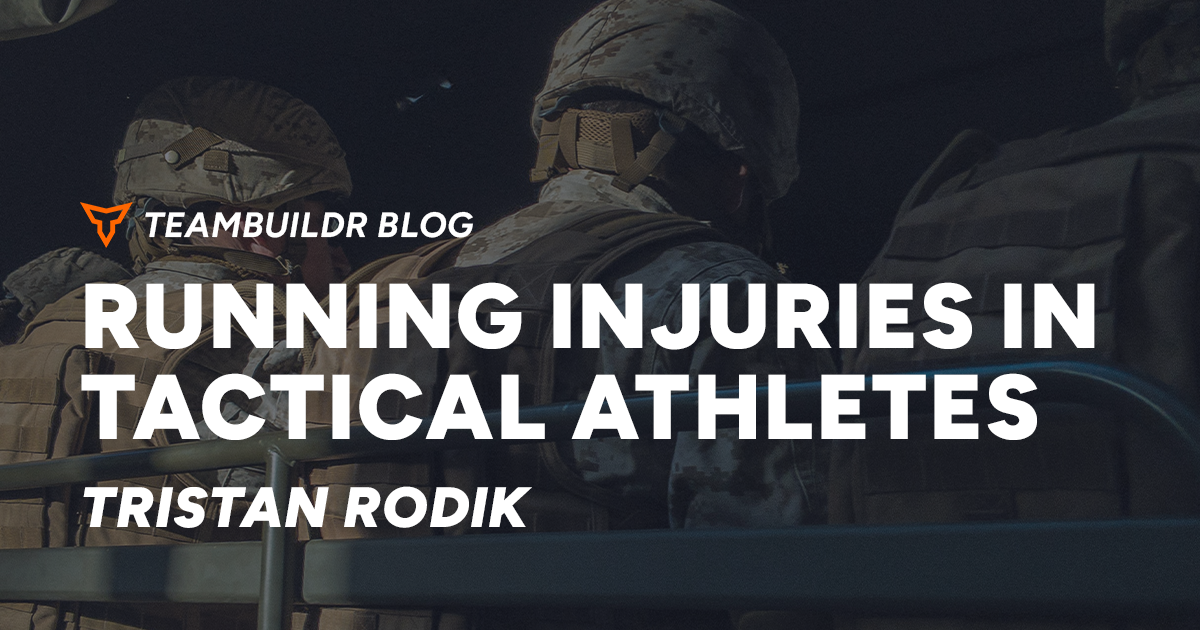A Mini-Manual For Injuries in the Tactical Athlete
Within the tactical setting there are many moving pieces. One of the biggest pieces that can affect the coach on a day-to-day basis is injuries sustained during training, TDYs, Deployments or in the field respective to the tactical athlete. When they come up how do we adjust as coaches? Do we modify that day? What about the whole mesocycle or macrocycle? The severity of the injury will determine the proper course of action needed within programming.
In this article I would like to share some of the most common injuries I have seen as a coach during my time as a tactical practitioner. The main categories are: Lower Body, Upper Body and Spinal related injuries. Please note that we are not physical therapists or athletic trainers who are qualified to diagnose and treat medical conditions; however, having the knowledge to decrease the likelihood of injury/help restore that body is needed for the tactical side of the field. Please make sure that if you need a higher level of medical examination refer your athletes or yourself to seek professionals who are qualified to diagnose and treat.
Lower Body
Hip
The most common issues we see within the hips are within the groin, hip flexor and internal rotation capabilities. With modern day lifestyle (lack of proper sleep, diet, seated desk, etc.) the athlete is highly susceptible to hip mobility issues and strains on the hip flexor and adductor muscles. It may start off as tightness, but will eventually proceed to overuse or higher-level strains/tears if not addressed properly.
Solutions
Hip flexor – Restoring hip flexor mobility pre-training/post-training makes for a great solution to decrease the possibility of injury. This could be done within reps ranges of 5-15 reps each side.
Knee
The knee takes so much stress due to impact stemming from running, jumping, rucking, etc. As the knees begin to have stress added we need to modify the program. This can be done in several ways depending on the level of pain.
The option first is to limit load. Limiting load will depend on the level of pain and what the athlete was doing. For example, if the athlete destroyed their legs on a 14-mile ruck through the mountains, then perhaps dropping the load or even utilizing an RPE system would be a better approach to the training session/mesocycle.
The second option is to add isometrics to the warm ups or main lifts. Adding in 4-6 sec isometrics can increase the size/strength of the overused tendons while limiting the load on the knees for lower body-based movements. From my practical experience, I try to keep total time under tension under 30 seconds for bilateral movements and under 40 total seconds for unilateral movements. Intensities should be done at or below pain threshold. If pain is not present and you would like to add in isometrics for other reasons, I recommend staying within the 70-85% for a volume range of 3-6 sets x 2-4 reps.
The third approach is to build up the hips and ankles. Sometimes the issues stem from another place in the body. For example, my old knee pain when I played high school basketball stemmed from having weak hips and ankles. When the areas such as those are weak, the knee will take most of the burden and have a higher likelihood of compensation during those athletic activities.We can increase the strength of the hips through RDLs/Deadlifts or through any weighted hip bridge variation.
Lastly, we look to build up the vastus medialis oblique (VMO). This small teardrop muscle is responsible for the local stabilization of the knee joint. This exercise is very useful when the knee does not track properly over the toe. By adding high volume to this area, we are able to increase the size and stability of the muscle joint to prevent pain from occurring during chaotic movement in the field or during vigorous exercise. Personally, I love utilizing TKEs (terminal knee extensions) for this effort with 1-2 sets of 20-30 reps each leg. See image below for clarity.
Ankle
The ankle joints will always be an issue within the tactical community because they are at the base of the lower extremities with the entire body above them. To help mitigate the likelihood of injuries from occurring at the ankle joint, I recommend utilizing ankle mobility drills for 5-10 reps each ankle prior to training. To also help increase the stabilization of the ankle under that mobility I recommend using isometric calf raises, high volume multi angle calf raises, and loaded toe walks.
For the 4-way calf raise use 10-12 reps per way to hit all angles of attack the calf.- 1st angle – toes out 45 degrees
- 2nd angle – toes facing forward
- 3rd angle – toes facing 45 degrees inward
- 4th angle – rock back on heels, then proceed to finish a full rep on the toes
Note: If Isometrics are added, I would drop the volume significantly to 4-6 reps per angle
Loaded toe walks – This exercise is performed as a loaded carry but you must remain on your toes at all times. I personally love to use this during higher intensity days in the weight room and use both forward, backward, and lateral variations on this movement
Note: The first couple sessions where this movement is performed the ankles and calf will be fatigued to a higher degree so make sure to program around in field training appropriately
#2: Upper body
Shoulder
Common shoulder injuries are predominantly in the anterior section of the shoulder. The most common ones I have seen and programmed for are upper cross syndrome, anterior shoulder impingement, and tight AC joints.
Note: For all of these the best thing you can do is consistently train the upper back (lats, low traps, rhomboids, posterior deltoids, etc.) with a 2-4:1 posterior to anterior training. Basically, for every press you do, you should be performing 2-4 times more pulling/posterior shoulder work.
Example:
A1. Bench Press 4x5
A2. Neutral Grip Pulldowns 4x10
A3. Chest Supported Rear Fly 4x12-15
To help prevent anterior shoulder issues I love utilizing the Apply Shoulder stretch with a towel. Traditionally I have the athlete move through the motion while keeping the towel as vertical as possible. The lower arm should be connected to the body with the belly button tucked in for proper posture. This will enhance the effectiveness of the stretch. 30-45 sec each side is a very good volume range per shoulder that has always worked for any tactical athletes I work with.
Elbow
Elbow injuries are common from an overuse stand point from physical training (combative or calisthenics) in the field or done within leisure activities such as golfing/tennis on the weekend. The main thing is to figure out which side of the elbow the pain is on and adjust the modifications from there.
Tennis Elbow
This is when the pain is around the outside of the elbow.
Some common fixes are:
- A basic fist clenched with a tennis ball or towel in hand. Arm should have the palm facing up and the outside of the elbow should be supported by a bench/box.
- Dumbbell Supinations – These are done by gripping the head of a very light dumbbell and rotating the palm down and up. Volume should be adjusted based on pain. I would recommend starting lower volume and working up from 10 reps for 1-2 sets
Golfer’s Elbow
This occurs when pain is on the tip of the bony bump of the elbow. Some common fixes are:
- Stretching out the extensors will be the best bet to restore the function of the elbow joint. Have the athlete slowly work into the stretch and increase the tension slowly as needed. 30 seconds each side has worked well in the past for my athletes specifically. See image below for a more visual representation
Wrist
Wrist injuries are pretty simple and standard. Mainly I just have my athletes rest and ice it. Programming is modified to limit grip utilization and forces that push down into the wrist, elbow, shoulder complex.
#3 : Spinal
Note: Spine related injuries are taken very seriously and normally require a deeper, more in depth look if injured. Please seek out an AT, PT or Doctor before trying to find a solution. The following below are common solutions to prevent cervical and spinal injuries
Cervical – Neck machine strengthening
Below are my protocols to use when training with a neck machine. If a piece of equipment is note available, then proceed with training all ROMs in the neck for 10-15 reps each ROM or performing each ROM for 30 seconds.
Neck Flexion
- Eyebrows in middle of cross pad
- Shoulders in-line with fulcrum of machine
- Set pin at 5 (unless using various pin settings)
- Press head forward then down
- Tempo 4-2-4
Lateral Flexion
- Same seat setting as neck flexion
- Set pin at 5
- Keep shoulders square (no oblique crunch)
- Ear to the shoulder
- Training Right side – Right hand on handle, left hand on seat
- Training Left side – Left hand on handle, right hand on seat
- Tempo 2-2-2
Neck Extension
- Seat down 2 notches from flexion
- Set pin at 3 (unless using various pin settings)
- Keep torso and shoulders still
- Tuck chin, then drive chin up
- Tempo 3-3-1
Lumbar Spine
- McGill Big 3
- 10 sec iso holds at each position
- McGill Crunch
- McGill Side Plank
- Bird Dog Isohold at end ROM
- Fist punched out like superman
- Back leg kicking a door closed, big toe pointed to the ground.
Decompression of the L1-SI joint:
- Hang from bar: 30-60 seconds
Hanging from a bar is arguably the simplest, but highly effective approach. When any human being does this; the lumbar spine will naturally decompress from gravity pulling the L1-L5 down into the floor. This in turn will force traction of the vertebrae and allow a natural vacuum for the disc to be sucked back into. I recommend doing this with any tactical population after any heavy squatting or deadlifting variations regardless of spinal loading or non-spinal loading methods being implemented.
Tempo Reverse Hyper:
Most athletes do not perform the reverse hyper correct and if low back strains are present, then the shear stress might create more problems down the line for the athlete. Putting the reverse hyper under 4 seconds up, 2 sec isohold & 4 sec down will allow the glutes, hamstrings to contract properly while allowing for the natural decompression of the lumbar spine to occur under a very low load.
Volume ranges that I normally implement are from 1-3 sets x 4-8 reps.
See image below for reference:
Conclusion:
Once again this is just a mini manual for how to navigate some of the most common injuries and issues seen within the tactical setting. If medical professionals are within your organization, please reach out to them, if need be, for further guidance. As a strength and conditioning coach who got into the TSAC side of the field at a very young age, I wanted to create this as a tool kit for other younger coaches who may have not had access to some of the resources that I have scavenged over the years. Remember injuries will happen on this side of the field, but it is up to us as professionals to keep pushing the TSAC section forward to work around, prevent and assist in fixing these injuries through our scope of practice.
Subscribe to our blog
Subscribe to receive the latest blog posts to your inbox every week.
Related posts

Running Injuries in Tactical Athletes: What Coaches Can Do About It?

My Journey to Tactical: Comparisons to the College Sector
